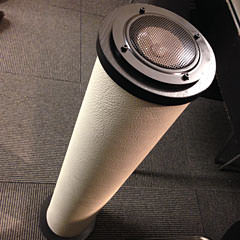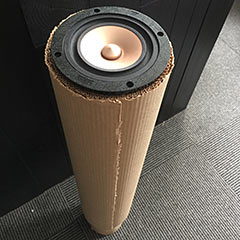Backloaded horn speakers are musical instruments

The second prototype is a back-loaded horn speaker.
[Motivation]
When I tried making carpet speakers, I was interested in back-loaded horn speakers, which are popular among DIY builders. There are many examples, and I was curious about what kind of sound they would produce, so I decided to make one myself.
[About backloaded horn]
When you search on the Internet, you will find examples of back-loaded horns, which, although they are called horns, are not pure horns. They contain many elements of an acoustic labyrinth and a resonating tube.
It is made from straight parts and is folded back at 180 and 90 degrees multiple times to ensure the horn length, with many sections that are parallel to the pipe.
Low-pitched sounds are diffracted more easily. Also, if the sound is bent 180 degrees, the mid- and high-pitched sounds are absorbed when it is reflected, and the low-pitched sounds remain.
In other words, the idea is to extract only the low frequencies by bending the horn. Multiple standing waves should also be generated, and I think the principle behind this is different from that of a horn.
Also, while there are many reports that the diaphragm can move freely, as the word "loaded" suggests, it has an air chamber and a throat, so it is subject to a certain amount of internal pressure. Although it is not as heavy as a bass reflex or sealed speaker, it should be greater than a cylindrical speaker.
Since this is a back-loaded horn, I wanted the duct to be horn shaped.
The idea that came to mind was to use a void tube, which is commonly used in architecture, to create something close to a horn shape while still being compact.
[Void tube spiral]
First, cut the void tube in half. Then connect each half of the void tube so that the radius gets gradually larger.
Each void tube will be cut in half, so we can make exactly two sets.
This has enabled us to create a horn shape that is close to the ideal, with absolutely no wasted space in the sound path and in an extremely compact design.
Then you sandwich it between two boards.

Due to precision issues, there were some gaps, so I used Chinori, a common material used in design offices. It is less prone to shrinkage than wood glue and is cheaper than epoxy.
However, since it has little viscosity, I used it to fill in gaps after gluing it with wood glue.
The paint used is our standard India ink, which is extremely inexpensive and easy to apply.

[Speaker units, etc.]
The speaker unit is TangBand's W3-881SJ.
We decided to adopt this product because we liked its incredibly thin diaphragm, powerful neodymium magnet, and unique shape that seems to allow sound to escape easily from the back.
And this little unit has better bass than you'd expect from its appearance.
Many people are particular about the material, but I imagine that if the horn is firmly attached to the enclosure, it will act as a rib and significantly increase the surface rigidity, so it doesn't really matter.
[Sound impressions]
Now it's time to play the completed speaker.
It just sounds better. The speaker efficiency is higher than carpet. (The same volume sounds louder.)
This is natural, as the smooth horn shape and the lack of sound-absorbing material means sound is transmitted without any loss.
The horn produces a considerable amount of bass as well as mid- and high-range sounds.
Carpet speakers cannot reproduce bass to this extent.
However, female vocals sounded faint and the balance was a little off. Also, the sound was too muffled and muddy.
So I replaced the speaker unit with a FOSTEX FE83en.
The mid- and high-range tones are clearer, while the amount of bass is more subdued compared to the W3-881SJ.
According to calculations in the beginner's DIY speaker course, the throat area is too large and the crossover frequency would be ideal if it was closed about halfway, so we attached sound-absorbing material all around the air chamber and adjusted the throat area.
Also, since the air chamber has a circular cross-section, sound is repeatedly reflected, which may be the cause of muffled sound, so this is also an effective countermeasure against that.
As a result, the sound is clearer and the bass is slightly less, but still sufficient.
It's a very beautiful sounding speaker.
Then, I suddenly realized that this was not a speaker but an instrument.
It may be easy to imagine the sound characteristics if you recall the sound of a conch shell or a horn-shaped instrument.
This makes the sound source resonate louder and creates a sense of reverberation.
It's no wonder that back-loaded horns have so many fans, given their pleasant sound.
However, when playing audio such as English conversation, the voices are muffled and difficult to hear, and it is clear that they are much muffled compared to the carpet.
Of course, I think the speaker I created has too much resonance, but more or less, I think this characteristic is the fate of a back-loaded horn, which has a wide baffle surface and is prone to internal resonance, vibration, and reverberation.
The invention of the swan-type backloaded horn by the famous Tetsuo Nagaoka was likely a response to a similar problem.
It's a matter of preference, but to me back-loaded horns seem to have a slightly different directional quality.

